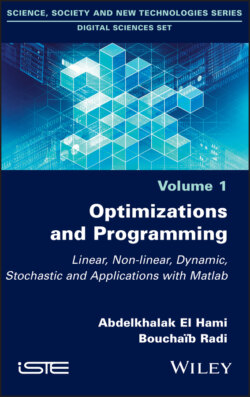Читать книгу Optimizations and Programming - Bouchaib Radi, Ghias Kharmanda, Michel Ledoux - Страница 44
1.12. Using Matlab
ОглавлениеMatlab offers the linprog solver for optimizing LPs. The linprog solver takes the following input arguments:
– f: the objective function;
– A: the matrix of inequality constraints;
– b: the right-hand side of the inequality constraints;
– Aeq: the matrix of equality constraints;
– beq: the right-hand side of the equality constraints;
– lb: the vector of lower bounds of the decision variables;
– ub: the vector of upper bounds of the decision variables;
– x0: the starting point of x, only used for the active-set algorithm;
– options : options created with “optimoptions”.
All linprog arguments use the following options, defined via the “optimoptions” input:
– Algorithm: the following algorithms can be used:1) “interior-point” (default);2) “dual-simplex”;3) “active-set”;4) “simplex”.
– LargeScale: the “interior-point” algorithm is used when this option is set to “on” (default) and the primal simplex algorithm is used when it is set to “off”.
– TolCon: the feasibility tolerance for constraints. The default value is 1e-4. It takes scalar values from 1e-10 to 1e-3 (only available for the dual simplex algorithm).
The output arguments of the linprog solver are as follows:
– fval: the value of the objective function at the solution x;
– x: the solution found by the solver. If exitflag > 0, then x is a solution; if not, x is the value of the variables when the solver terminated prematurely;
– exitflag: the reason why the algorithm terminated:- 1: the solver converged to the solution x;- 0: the number of iterations exceeded the “MaxIter option”;- 2: no feasible point was found;- 3: the LP problem is not bounded;- 4: a NaN value was encountered when executing the algorithm;- 5: the primal and dual problems are infeasible;- 7: the search direction became too small and no other progress was observed.
The following list specifies the various syntaxes that can be used to call the linprog solver:
– x = linprog(f, A, b): solves min fT x such that Ax ≤ b (used when there are only equality constraints);
– x = linprog(f, A, b, Aeq, beq): solves the problem with the equality constraints Aeqx = beq. Set A=[ ] and b=[ ] if no inequalities exist;
– x = linprog(f, A, b, Aeq, beq, lb, ub): defines a set of lower and upper bounds on the design variables, x, so that the solution is always in the range lb ≤ x ≤ ub. Set Aeq=[ ] and beq=[ ] if no equalities exist;
– x = linprog(f, A, b, Aeq, beq, lb, ub, x0): defines the starting point at x0 (only used for the active-set algorithm);
– x = linprog(f, A, b, Aeq, beq, lb, ub, x0, options): minimizes with the specified options;
– [x, fval] = linprog(...): returns the value of the objective function at the solution x;
– [x, fval, exitflag] = linprog(...): returns a value exitflag that describes the exit condition;
– [x, fval, exitflag, output] = linprog(...): returns a structure output that contains information about the optimization process;
– [x, fval, exitflag, output, lambda] = linprog(...): returns a structure output whose fields contain the Lagrange multipliers λ at the solution x.
EXAMPLE 1.14.– Consider the linear program:
[1.25]
The following code can be executed to compute this example.
1 1 variables = {'x1', 'x2', 'x3', 'x4', 'x5'}; % construct the vector x
2 2 n = length(variables);
3 3 for i = 1:n % create the indices of x
4 4 eval([variables{i}, ' = ', num2str(i), ';']);
5 5 end
6 6 lb = zeros(1, n);
7 7 lb([x1, x2]) = [5, 1]; % add the bounds of the variables x1,x2
8 8 ub = Inf(1, n);
9 9 A = zeros(3, n); % create the matrix A
10 10 b = zeros(3, 1); % create the vector b
11 11 % define the constraints
12 12 A(1, [x1, x2, x3, x4]) = [1, 4, -2, -1]; b(1) = 8;
13 13 A(2, [x1, x2, x3, x4]) = [1, 3, 2, -1]; b(2) = 10;
14 14 A(3, [x1, x2, x3, x4, x5]) = [2, 1, 2, 3, -1]; b(3) = 20;
15 15 Aeq = zeros(1, n); % create the matrix Aeq
16 16 beq = zeros(1, 1); % create the vector beq
17 17 % define the equality constraints
18 18 Aeq(1, [x1, x2, x3, x4, x5]) = [1, 3, -4, -1, 1]; beq(1) = 7;
19 19 c = zeros(n, 1); % create the vector c
20 20 c([x1 x2 x3 x4 x5]) = [-2; -3; 1; 4; 1];
21 21 % call linprog solver
22 22 [x, objVal] = linprog(c, A, b, Aeq, beq, lb, ub);
23 23 for i = 1:n
24 24 fprintf('%s \t %20.4f\n', variables{i}, x(i))
25 25 end
26 26 fprintf(['The value of the objective function is' '%20.4f\n'],
27 27 objVal)
For a color version of this code, see www.iste.co.uk/radi/optimizations.zip
Executing this code produces the following results:
